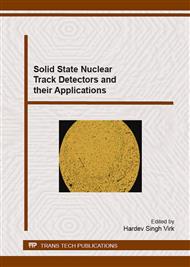[1]
United Nations Scientific Committee on the Effects of Atomic Radiation, Sources and Effects of Ionizing Radiation. UNSCEAR, United Nations, New York, (2000).
DOI: 10.18356/49c437f9-en
Google Scholar
[2]
World Health Organization (WHO), Handbook on Indoor Radon: A Public Health Perspective, WHO Press, Geneva, (2009).
Google Scholar
[3]
J. Miles, Development of maps of radon-prone areas using radon measurements in houses, Journal of Hazardous Materials 61 (1998) 53–58.
DOI: 10.1016/s0304-3894(98)00107-1
Google Scholar
[4]
K.N. Yu, T. Cheung, Z.J. Guan, E.C.M. Young, B.W.N. Mui, Y.Y. Wong, Concentrations of 222Rn, 220Rn and their progeny in residences in Hong Kong, J. Environ. Radioact. 45 (1999) 291–308.
DOI: 10.1016/s0265-931x(98)00114-3
Google Scholar
[5]
Z. Zhang, B. Smith, D.J. Steck, Q. Guo, W. Field, Variation in yearly residential radon concentrations in the Upper Midwest, Health Phys. 93 (2007) 288-297.
DOI: 10.1097/01.hp.0000266740.09253.10
Google Scholar
[6]
T.V. Ramachandran, B.K. Sahoo, Thoron (220Rn) in the indoor environment and work places, Indian J. Phys. 83 (2009) 1-20.
DOI: 10.1007/s12648-009-0086-z
Google Scholar
[7]
W.W. Nazaroff, A.V. Nero, Radon and its decay products in indoor air, John Wiley & Sons, New York, (1998).
Google Scholar
[8]
K. Kozak, J. Mazur, B. Kozlowska, M. Karpinska, T. A. Przylibski, K. Mamont-Ciesla, D. Grzadziel, O. Stawarz, M. Wysocka, J. Dorda, A. Zebrowski, J. Olszewski, H. Hovhannisyan, M. Dohojda, J. Kapala, I. Chmielewska, B. Klos, J. Jankowski, S. Mnich, R. Kolodziej, Correction factors for determination of annual average radon concentration in dwellings of Poland resulting from seasonal variability of indoor radon, Applied Radiation and Isotopes 69 (2011) 1459-1465.
DOI: 10.1016/j.apradiso.2011.05.018
Google Scholar
[9]
G.K. Gillmore, P.S. Phillips, A.R. Denman, The effects of geology and the impact of seasonal correction factors on indoor radon levels: a case study approach, J. Environ. Radioact. 84 (2005) 469–479.
DOI: 10.1016/j.jenvrad.2005.05.004
Google Scholar
[10]
E. Stranden, L. Berteig, F. Ugletveit, A study on radon in dwellings, Health Phys. 36 (1979) 413–421.
DOI: 10.1097/00004032-197903000-00018
Google Scholar
[11]
T.V. Ramachandran, B.Y. Lalit, U.C. Mishra, Measurement of radon and thoron present in the environment using nuclear track etch technique, Nucl. Tracks Radiat. Meas. 11 (1986) 245–249.
DOI: 10.1016/1359-0189(86)90041-5
Google Scholar
[12]
S. Singh, A. Kumar, B. Singh, Radon level in dwellings and its correlation with uranium and radium content in some areas of Himachal Pradesh, India, Environ. Int. 28 (2002) 97-101.
DOI: 10.1016/s0160-4120(02)00012-0
Google Scholar
[13]
R.C. Ramola, R.B.S. Rawat, M.S. Kandari, T.V. Ramachandran, K.P. Eappen, M.C. Subha Ramu, Calibration of LR-115 Plastic Track Detectors for Environmental Radon Measurements, Indoor and Built Environment 5 (1996) 364-366.
DOI: 10.1159/000463753
Google Scholar
[14]
H.S. Virk, N. Sharma, B.S. Bajwa, Environmental radioactivity: a case study in Himachal Pradesh, India, J. Environ. Radioact. 45(1999) 119-127.
DOI: 10.1016/s0265-931x(98)00084-8
Google Scholar
[15]
H.S. Virk, N. Sharma, Indoor radon levels and inhalation doses to population in Punjab, Curr. Sci. 78 (2000) 1418-1420.
Google Scholar
[16]
B.S. Bajwa, H.S. Virk, S. Singh, A comparative study of indoor radon level measurements in the dwellings of Punjab and Himachal Pradesh, India. Radiat. Meas. 36 (2003) 457-460.
DOI: 10.1016/s1350-4487(03)00171-9
Google Scholar
[17]
D. Nikezic, C. Baixeras, Analysis of sensitivity of LR115 in cylindrical diffusion chambers for radon concentration determination, Nucl. Instrum. Methods Phys. Res. A 364 (1995) 531–536.
Google Scholar
[18]
D. Nikezic, C. Baixeras, D. Kostic, Sensitivity determination and optimisation of a cylindrical diffusion chamber, for radon measurements, with a CR-39 detector, Nucl. Instrum. Methods Phys. Res. A 373 (1996) 290–298.
DOI: 10.1016/0168-9002(95)01507-8
Google Scholar
[19]
D. Nikezic, N. Stevanovic, Behavior of 220Rn progeny in diffusion chamber, Nucl. Instrum. Methods Phys. Res. A 570 (2007) 182–186.
DOI: 10.1016/j.nima.2006.10.001
Google Scholar
[20]
Y.S. Mayya, K.P. Eappen, K.S.V. Nambi, Methodology for mixed field inhalation dosimetry in monazite areas using a twin-cup dosemeter with three track detectors, Radiat. Prot. Dosim. 77 (1998) 170-184.
DOI: 10.1093/oxfordjournals.rpd.a032308
Google Scholar
[21]
K.P. Eappen, Y.S. Mayya, Calibration factors for LR-115 (Type-II) based radon thoron discriminating dosimeter, Radiation Measurements 38 (2004) 5-17.
DOI: 10.1016/j.radmeas.2003.09.003
Google Scholar
[22]
B.K. Sahoo, B.K. Sapra, S.D. Kanse, J.J. Gaware, Y.S. Mayya, A new pin-hole discriminated 222Rn/220Rn passive measurement device with single entry face, Radiation Measurements 58 (2003) 52-60.
DOI: 10.1016/j.radmeas.2013.08.003
Google Scholar
[23]
P.K. Hopke, N. Montassier, P. Wasiolek, Evaluation of the effectiveness of several air-cleaners for reducing the hazard from indoor radon progeny, Aerosol Science & Technology 19 (1993) 268-278.
DOI: 10.1080/02786829308959635
Google Scholar


